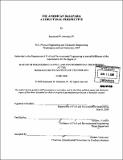The American ballpark : a structural perspective
Author(s)
Sweeney, Raymond W. (Raymond Winfield)
DownloadFull printable version (40.70Mb)
Other Contributors
Massachusetts Institute of Technology. Dept. of Civil and Environmental Engineering.
Advisor
Jerome J. Connor.
Terms of use
Metadata
Show full item recordAbstract
A recent boom in ballpark construction in the last decade has brought great attention to the design of these stadiums. The purpose of this thesis is to examine the history of the American ballpark through the 20th century, and to compare the structural systems of the different ballparks. This evolution is quite evident in the city of Philadelphia, where ballparks of all three major eras have been built in the last century. In the early 1900s, many ballparks were beginning to shift from wood to steel and concrete. The Jewel Box ballparks were considered some of the best of all time, and some are still in use today. However, many of them fell into disrepair and were eventually replaced, often times with a multi-purpose stadium. Initially hailed as great feats of engineering, many of these "cookie-cutter" parks did not age well and quickly fell out of favor. The 1990s would bring a revival of the "retro" ballparks, beginning with Baltimore's Oriole Park. In Philadelphia, the Baker Bowl, Shibe Park, Veterans Stadium, and Citizens Bank Park serve as an excellent indicator of the evolution of the ballpark. There will likely be a lull in ballpark construction in the coming years, just as few stadiums were built in the 1940s and '50s. As the current ballparks age, owners will again be faced with the decision to renovate or rebuild.
Description
Thesis (M. Eng.)--Massachusetts Institute of Technology, Dept. of Civil and Environmental Engineering, 2008. Includes bibliographical references (leaves 66-67).
Date issued
2008Department
Massachusetts Institute of Technology. Department of Civil and Environmental EngineeringPublisher
Massachusetts Institute of Technology
Keywords
Civil and Environmental Engineering.